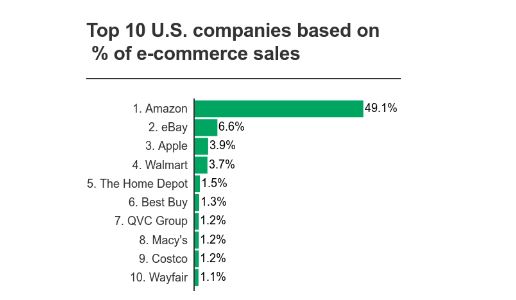
What does SEO mean to you? It’s likely that Google comes to mind, given that the search engine receives roughly 63,000 searches per second, and holds 90.46% of the search engine market share worldwide.
If you’re an eSeller on Amazon and want to outrank the competition you need to ensure that your products are being found in searches and that they’re indexed. Every month more than 197 million people around the world get on their devices and visit Amazon, and in 2018 alone, Amazon’s share of the U.S. eCommerce market hit 49%.


Source: emarketer.com
Want a piece of that profitable pie? Here’s how…
Amazon’s A9 Search Algorithm
Amazon’s search algorithm known as A9 works differently than any Google or Bing algorithm in surfacing results, so understanding exactly how it operates is important.
Simply put, A9 is composed of a variety of factors that are used to match users’ searches to products they’re most likely to purchase. As an eSeller, you know that the biggest challenge isn’t necessarily your competition as much as it is getting your products found through those searches.
Note that according to data from Amazon:
- 70% of Amazon customers don’t ever click past the first page of search results
- 35% of Amazon shoppers click on the first featured product they see
- The first three items displayed in search results account for 64% of clicks
- 81% of clicks are on brands on the first page of search results
A9’s main goal is converting a sale and if there’s one thing to know about Amazon’s SEO, it’s that it cares about buyers and selling to them. It sounds obvious, but it’s important to remember when optimizing your product listings. There are a variety of factors that influence A9. According to Amazon:
“Customers must be able to find your products before they can buy your products. Search is the primary way that customers use to locate products on Amazon.
Customers search by entering keywords, which are matched against the information (title, description etc.) you provide for a product.
Factors such as degree of text match, price, availability, selection, and sales history help determine where your product appears in a customer’s search results.”
Next thing you have to understand is keyword indexing.
What is Amazon Keyword Indexing?
Being indexed means that when users type a keyword into the search bar on Amazon, it will bring up your product on the search results. The more you’re indexed for highly relevant keywords, the more traffic and sales you will get.
Increasing the number of keywords, you’re indexed for increases the ways your customers find your products, but conversely, you miss out on potential traffic if you’re not indexed for as many highly relevant, purchase intent keywords as possible.


The key word is “relevant.”
You don’t want to cram dozens of keywords for every single product in hopes that something sticks. In fact, because Amazon rewards conversions and sales, traffic that does not result in conversions actually makes your products less appealing to A9, so relevant keywords are critical to your success.
Focus on keywords that will attract future buyers, check your keywords often for relevancy and conversions, and adjust accordingly. Fortunately, there are also steps you can take in addition to keywords to optimize your Amazon SEO.
How to Make the Most of Your Product Listings
Keyword research will always be at the heart of Amazon optimization, as their goal is to serve the most relevant products to searchers. The only way your product can be found for a specific search query is if the product listing contains the keyword searched, so make a master lists of relevant keywords.
Now that that’s done, you’re probably wondering, “How can I improve my ranking?”
Your Listing’s Title
Your product title is the part of your listing that will either make or break your ranking when it comes to product performance in search. It should contain:
- Brand
- Product line
- Material or key feature
- Product type
- Color
- Size
The order in which you place these elements is important, as the algorithm correlates higher relevance with keywords that appear earlier in the title. A good formula to follow includes:
[Brand Name] – [Product Type] – [Feature #1] – [Feature #2] – [Feature #3] – [Size, etc.]
Optimize Product Bullets and Descriptions
The next most important factor is highlighting your product’s features and describing your product in a way that presents the benefits — something Amazon takes very seriously.
Remember that master list of keywords? The ones that weren’t used in the title should be worked into the bullets. Some tips for optimizing bullet points include:
- Highlight the top five features that you want your customers to consider, like warranty information, dimensions, or age appropriateness
- Be as specific as possible with product features and attributes
- Don’t include price, shipping, or company information
This is your chance to tell a bit about your brand and product, while adding in some valuable keywords you want indexed. Remember that if they’re reading the description, they’re already on your product page. Now is the time to include a strong call to action.
Focus on the user experience by using a more conversational voice that focuses on how the product will enhance that customer’s life. Adding in a few lifestyle images of people using your product in some way can also help amplify conversions. Here you can tell a complete story and get your audience to connect with you and your product.
Optimize Amazon Backend Keywords
As the name implies, back-end keywords are keywords that aren’t found on the front- end, which gives you the chance to get more creative. While these keywords aren’t visible to customers, they still get indexed just like the terms in your bullets and description and are a great way to target long-tail keywords.
Some tips include:
- Including alternate spellings
- Adding in related search terms
- Thinking of creative, out-of-the-box queries that are related to your niche
While customers never see these keywords, they are instrumental in pushing your listings to the top.
In conclusion, one of the easiest solutions to make your product easy to find on Amazon is to make sure that it’s appropriately indexed. Not only does it help increase your organic ranking, but it also allows you to decrease your reliance on advertising or paid search when selling your products on Amazon.
By putting these suggested steps into action, you’re well on your way to increasing your ranking and increasing your sales!




